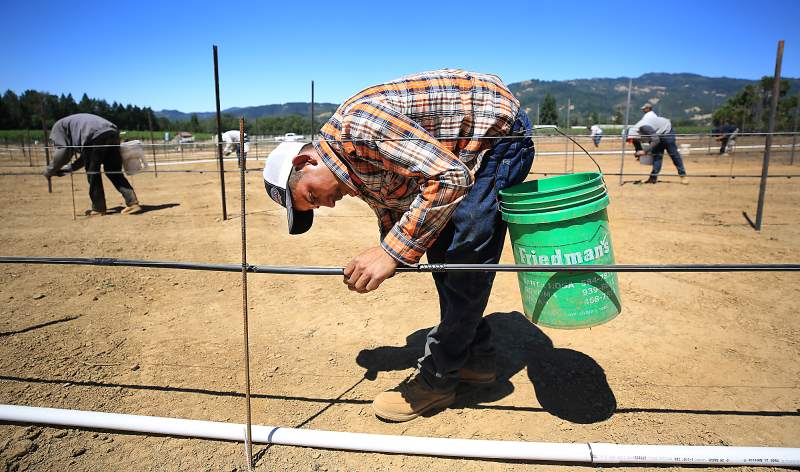
In the small town of Redwood Valley in Mendocino County, Martha Barra has tried almost everything to recruit vineyard workers to her Redwood Valley Vineyards.
Barra has canvassed the local Mexican restaurants and advertised in Spanish-language newspapers, which resulted in a few employees. She has reached out to the Mendocino County Jail for inmates to work on her more than 300 acres, which feature cabernet sauvignon vines that go back more than 60 years. A few of those men were later hired after they completed their sentences.
She has relied on outside labor contractors, which later backfired. “We found that unsuccessful, as they would tell us they would be here on a Tuesday with 15 men, which is a good crew. Maybe five would show up, or maybe none at all,” Barra said. “It became critical that we have reliable help.”
Fed up, Barra turned this year to the federal H-2A program, which allows agriculture employers to hire foreign guest workers for jobs lasting up to 10 months. Seven workers from Mexico arrived May 8 at Barra’s farm to help out on tasks in advance of this year’s grape harvest.
The results so far have been positive.
“Our foreman is very pleased,” said Barra, who markets her wine under the Barra of Mendocino label to 35 states and four foreign countries.
Barra is not alone; other North Coast vineyard management companies and wineries have also jumped on the H-2A bandwagon this year, citing a dearth of available local farm workers. In Sonoma County, according to a tally from the U.S. Department of Labor’s website, local businesses requested 291 foreign workers this year through the H-2A program.
The H-2A uptick comes as the state and region grapple with an extremely tight labor market as well as the realization that an immigration overhaul is unlikely to occur under the Trump administration.
“It’s the only option. There is no avenue to take to get labor to work in the fields,” said Duff Bevill of Bevill Vineyard Management of Healdsburg, which brought in 24 workers from Mexico this year. “Seven or eight years ago, we would have people coming in for jobs and we would hire them.”
The trend is occurring statewide; a Los Angeles Times analysis this year found that California’s total number of H-2A workers reached 11,000 in 2016, which was five times as much as in 2011.
To receive foreign workers through the H-2A program, employers must show that they cannot find U.S. workers to meet their labor needs. They must provide housing and actively recruit workers to bring in on a temporary legal basis. The employees are not undocumented, nor can they be admitted into the process toward citizenship. They are protected under federal and state labor laws, though labor activists contend the system is rife with abuse and helps drive down wages for local workers.
The H-2A program has typically been popular in other parts of the country, such as Florida, with its large citrus crop, and North Carolina, which besides its famous tobacco crop also produces Christmas trees and fruits and vegetables. Notably, Trump Vineyard Estates in Charlottesville, Virginia, owned by the president’s son, Eric Trump, has used the program, asking for 23 foreign workers this year.
Until recently, California farmers have not been large users of the H-2A program. In 2015, California ranked fifth in H-2A usage despite being the top agricultural producer in terms of cash value.
Instead, California historically has relied heavily on undocumented farm workers. The U.S. Department of Labor’s National Agricultural Workers Survey puts the number of undocumented farm workers historically at around 50 percent, but some surveys contend it grew as high as 70 percent in California, or as many as 560,000 people.
The North Coast has tended to attract a much less migrant agricultural workforce. The vineyard work attracts higher wages because the region’s premium wine grapes are one of the most profitable crops in the state. That has allowed vineyard management companies to offer higher pay to lure workers with $13 to $15 an hour for entry level jobs and as much as $30 an hour during harvest. The state’s minimum wage is at $10.50 an hour.
Those workers, in turn, have stayed in the community. A survey by the Sonoma County Winegrowers trade group last month found the local industry employs 5,186 full-time workers, a number supplemented by 2,644 seasonal workers. The trade group said the hourly wage in the county is $16.34 an hour for vineyard employees.
But the local workforce has not expanded. The reasons are varied and include stepped-up immigration enforcement that began under the Obama administration, workers now opting to stay in Mexico and competition from other industries, most notably construction. In addition, farm worker children are opting not to work in the fields.
Barra noted some of the children of her farmworkers were raised on her property, but they are not following their parents into the vineyards. “These kids are going to college. It’s wonderful,” she said.
The labor crunch has resulted in the local wine industry reaching out to immigration lawyers such as Jeanne Malitz of San Diego, who has handled H-2A applications for many Sonoma County farmers.
“We are seeing it in the wine grape industry,” said Malitz, who handled the application for Bevill. “We get calls all the time now saying, ‘It’s urgent and when can we start?’”
The program is geared to larger operations, as the companies must provide housing for the workers. The big expense for the workers, who in California will be paid at a rate of $12.57 an hour this year, is providing for their own food.
Robledo and Sons houses its 18 H-2A workers this year at a bunkhouse in Sonoma and another facility on Lake County property, said owner Jenaro Robledo.
“With all the hurdles you have to go through, housing is the biggest one,” Robledo said. “Maybe we will increase it next year.”
Bevill said he also wants to build more bunkhouses, given that he already has seen the benefits of importing a work crew. “I’ve got to build more housing,” he said.
Recruitment must be done carefully. Malitz said she uses only one foreign recruiter that she trust for her clients to avoid unscrupulous outfits. Barra noted she had an advantage as her foreman, Roberto Gonzalez, went down to the state of Michoacán in Mexico and recruited workers that he could personally vouch for.
While growers laud the benefits of the visa program, critics such as the United Farm Workers charge that it exploits workers. They note that H-2A doesn’t have any cap on the overall number of workers who can be brought into the United States. A total of 134,368 workers arrived last year, allowing for a potential unlimited supply of foreign workers. In contrast, the H-2B program for seasonal non-agriculture workers is capped at 66,000 visas annually, though Congress just doubled that amount.
The H-2B program is for jobs in industries such as landscaping, seafood processing, timber, and tourism.
“The history of the program shows these guest workers are very vulnerable to abuse and many employers take advantage of those vulnerabilities,” said Bruce Goldstein, president of Farmworker Justice, a Washington, D.C.-based advocacy group.
His group authored a 2011 report that outlined complaints about the program, charging that it drives down wages for U.S. workers and creates an incentive to hire more foreign workers because employers do not have to pay Social Security or unemployment taxes on H-2A employees. It also claimed that some foreign workers have experienced wage theft and that abuses in recruitment are common, but the workers do not complain to authorities.
Goldstein advocates legislation that would allow undocumented farm workers to gain citizenship. Sen. Dianne Feinstein recently introduced such immigration legislation to provide them a path toward legal status.
Feinstein believes that such a path towards legal status for undocumented workers is the only avenue to address the concerns of both farmers and workers, especially given the fear of deportation.
Under her bill, those who have worked in agriculture for at least 100 days in each of the past two years may earn a “blue card” status. Farm workers who maintain that status for the ensuing three to five years, depending on the total hours worked, would be eligible to obtain a green card as a legal permanent resident. The bill did not address the H-2A program specifically, as her past measures have.
“Farm labor is performed almost exclusively by undocumented immigrants — a fact that should surprise no one,” Feinstein said in a statement when she introduced the bill in May. “By protecting farmworkers from deportation, our bill achieves two goals — ensuring that hardworking immigrants don’t live in fear and California’s agriculture industry has the workforce it needs to thrive.”
That fear came to Lake County in May, when agents from the U.S. Immigration and Customs Enforcement visited a farm camp in Finley. Three undocumented workers were apprehended in the visit as agents were initially looking for a man with a criminal record who did not live at the site, said Ana Santana, a member of Latinos United of Lake County. An ICE spokesman, James Schwab, said he could not comment on details of the action.
The California Farm Labor Contractor Association on May 24 sent an email alert to its members about the incident, noting it “wanted to pass this along so others can take appropriate measures to ensure the safety of their employees.”
Keith Brandt of Bella Vista Farming Co. in Kelseyville said that none of his employees were affected, but the incident did spread fear and apprehension among local vineyard workers and their families.
“From what I gathered (that) morning, it’s really reverberated within our labor community,” Brandt said. Santana agreed. “I wish the people in the current administration knew the effect this is having,” she said.
Brandt said the Lake County labor market is very tight, especially as workers can make more money in nearby Napa County. “There’s always folks looking for greener pastures,” he said. Like others, Brandt said he also is considering the H-2A program.
The H-2A program requires agriculture employers to demonstrate that there are not enough U.S. workers who are “able, willing, qualified and available to perform work at the place and time needed.” Barra said she had two applicants for the positions that she advertised as required under H-2A rules.
“One was a mushroom picker on the (Mendocino) coast. The other was a woman who didn’t want to work weekends and no overtime. I don’t think she understood agriculture is 10 hours (a day),” Barra said. “They disappeared. I would call them back, there was no response.”
She eventually did hire one local man as part of a hiring effort with the H-2A program, though he later left the position.
“It’s not like we have been sitting on our hands waiting for them. They are not coming like they used to,” Barra said.
